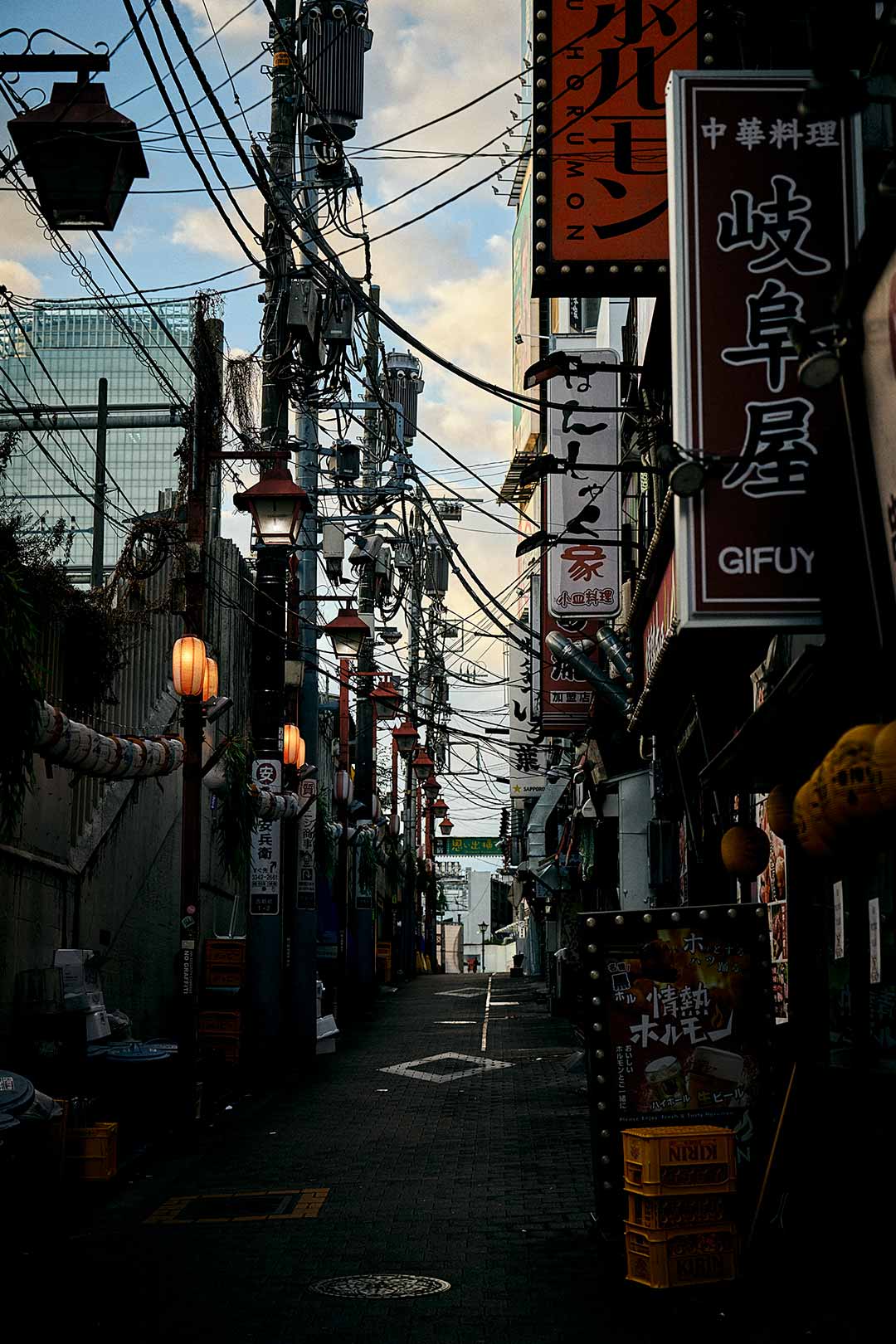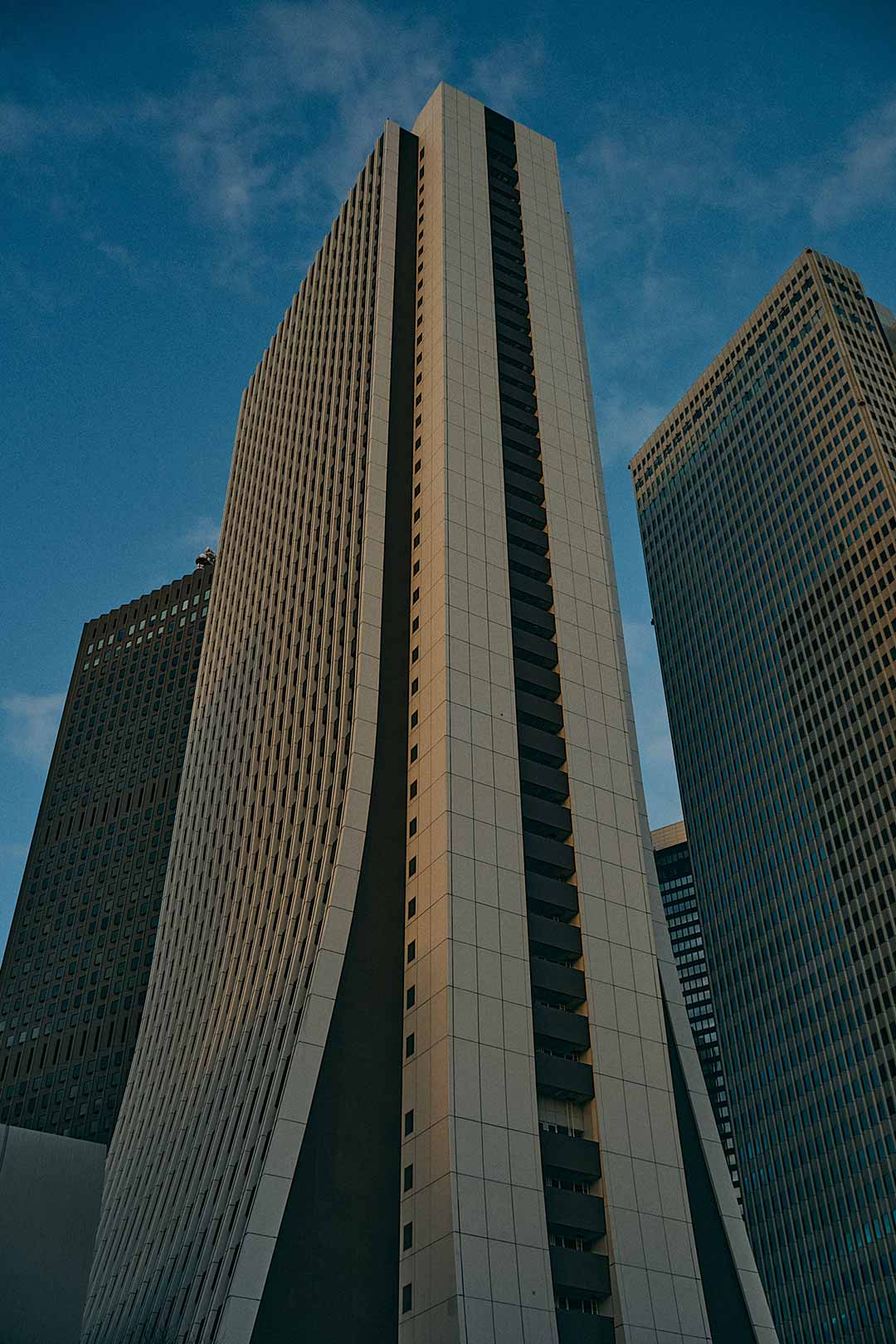1960年代から “若者文化の聖地” として独自のカルチャーを発信し、
さまざまなジャンルのクリエイターたちに多大な影響を与えてきた街「新宿」。
NEPENTHES代表・清水慶三にとっても、
そこは、幼少期の記憶に深く刻まれた東京の原風景であり、
若き日にファッションデザイナーとしての感性を育んだ特別な場所だった。
さまざまなジャンルのクリエイターたちに多大な影響を与えてきた街「新宿」。
NEPENTHES代表・清水慶三にとっても、
そこは、幼少期の記憶に深く刻まれた東京の原風景であり、
若き日にファッションデザイナーとしての感性を育んだ特別な場所だった。
Known as “the epicenter of youth subculture” since the 1960s, Shinjuku has been inspiring various types of artists with the distinct vibe. And it is no exception for Keizo Shimizu, the CEO of NEPENTHES. The town is etched in his childhood memory of Tokyo and, later cultivated his sensitivity as a fashion designer during his youth.
ファッションに目覚めた少年時代の新宿体験

- 子どもの頃、新宿で洋服を買ってもらうのが、物心ついたときからの楽しみでした。行くのは、春と秋の年二回。母と三つ上の兄と一緒に甲府駅から朝7時過ぎの中央線に乗って、新宿駅に到着するのが10時ぐらい。いつも最初に向かうのが「伊勢丹」で、兄が十代になってからは同じ新宿三丁目にあった「三峰」にもよく行くようになりました。

- もともと親が「伊勢丹」でよく服を買っていたんです。特に映画館の館長をしていた父は、映画の仕入れで東京に出張するたびに立ち寄っていたようで、ジャケットとパンツをカスタムオーダーしたり、〈Burberry〉のステンカラーコートを買ったりしていました。そんな家庭環境で育ったので、自分も自然とファッションに興味を持つようになりましたね。
- 買い物以外では、歌舞伎町にあったライブハウス「新宿ニューアシベ」に連れて行ってもらったときのことも、新宿の思い出として強く記憶に残っています。お目当ては母が好きだったグループサウンズのバンド。ザ・タイガース、ザ・スパイダース、ザ・テンプターズ。あとはザ・ジャガーズも観たんじゃないかな。
- 高校生になると、映画『アメリカン・グラフィティ』とカタログ雑誌『Made in U.S.A catalog』の影響で、それまで夢中だったアイビーに代わって50’sスタイルやアメカジにのめり込むようになりました。服を買いに行くエリアもトラッドっぽいファッションがメインだった新宿から、アメリカンブランドと古着を求めて原宿や渋谷へ。ただ、「伊勢丹」は〈LEVI’S〉の501や〈WOODS〉〈PIONEER〉といったヘビーデューティーなブランドをいち早く扱っていたし、その近くにあったメンズショップの「伊勢屋」や「ユウキヤ」には他の店ではあまり見ないインポート物が売っていたんですよね。なので、行く店は限られていたものの、相変わらず新宿通いは続けていました。
やきとん屋と「ツバキハウス」
- 高校卒業後は上京して代々木にあった「メンズファッション専門学校」に入学。住んだエリアも新宿に出やすい代田橋だったので、新宿が生活の中心地になりました。しかしながら、“ファッションの仕事に就く”という夢に向かって順調に歩みを進めたと思ったのもつかの間、試験に遅刻したことが原因でたった3ヵ月で退学処分になってしまったんです(笑)。それで、今後の身の振り方を考えていたとき、頭に浮かんできたのが、新宿にある「文化服装学院」で。以前に学校の先輩たちから、本気で洋服の仕事をしたいなら「文化服装学院」に行ったほうがいいと勧められていたんです。とはいえ、また親にお金を出してもらうというのも気が引けたので、入学金と授業料はアルバイトをして自分でお金を貯めることにしました。
- バイト先に選んだのは〈VAN〉。しかも勤務地は「伊勢丹」で、紳士別館の地下フロアにあった店舗に販売スタッフとして配属されました。約半年間、朝10時から夜7時まで週6のフルタイムで働いたおかげで、新宿にいくつかの行きつけのお店ができました。「伊勢丹」横の「とんかつ王ろじ」とカレー屋「ガンジー」。ロールキャベツが名物の洋食屋「アカシヤ」。喫茶店は「珈琲貴族エジンバラ」。歌舞伎町の「新宿バッティングセンター」にも、バイト帰りによく行きましたね。
- 翌年、晴れて「文化服装学院」に入学し、新宿で過ごす学生生活がふたたび始まりました。当時の「文化服装学院」は1クラスが大体50人で、そのうち男は5人くらい。しかも「文化」に来るようなファッション好きの男はDCブランド一辺倒な人たちばっかりで、最初はなかなか馴染めなかったんですが、それでも何人かの共通の好みを持つ仲間を見つけて親しくなってからは、金曜の学校終わりで夜の新宿に繰り出すようになりました。
- 新宿駅南口の甲州街道沿いにあった「文化服装学院」の学生たちが集まる居酒屋と、あとはやきとん屋で呑むことが多かったですね。新宿三丁目の「串元」。歌舞伎町の「番番」「カミヤ」「萬太郎」。西口の思い出横丁では、うなぎ串の「カブト」と中華料理の「岐阜屋」が行きつけ。呑んだ後は新宿テアトルビルの5階にあったディスコ「ツバキハウス」に流れるのがお決まりのコース。「ツバキハウス」はその頃の東京でいちばん華やかなスポットで、川久保玲さんや山本耀司さん、三宅一生さんなんかもよく見かけましたね。なかでも「金ツバ」と呼んでいた金曜日の盛り上がりがすごくて。Earth, Wind & Fire「Fantasy」がかかると、みんなフロアで踊り狂ってました。
Boy Meets Fashion in Shinjuku

- Even as a very small kid, I always looked forward to visiting Shinjuku with my family to get new clothes. We traveled there twice a year, spring and fall. My mother, three-years-older brother and I used to take a 7AM train on the Chuo Line from Kofu station to get to Shinjuku around 10AM. Isetan was always our first destination. After my brother became a teenager, we went to a store called Mitsumine, too. It was located in the same area as Isetan, Shinjuku – sanchome.

- Both of my parents loved Isetan, but especially my father. He was the owner of a movie theater and visited the department store whenever he traveled to Tokyo to purchase movies. I remember he got himself a tailormade jacket and pants, as well as Burberry’s Balmacaan coat there. Because I was raised by such parents, fashion naturally attracted my interest.
- Besides shopping, I can vividly recall when my mother brought me Shinjuku New ACB, a live music venue in Kabukicho. She went there to see her favorite rock bands such as the Tigers, the Spiders and the Tempters. I think we saw the Jaguars, too.
- During my high school years, I started to devote myself deep into 1950s and American Casual styles instead of Ivy League looks I used to love. The American Graffiti movie and Made in U.S.A. Catalog have certainly affected my taste in fashion then. So, to get vintage, US-made clothes, I went to Harajuku and Shibuya more often than Shinjuku where shops mainly carried traditional garments. But Isetan offered clothes from American Casual brands, including 501 jeans from LEVI’S, WOODS and PIONEER, from the very beginning of the trend, and some nearby stores, like Iseya and Yukiya, handled imported goods that I couldn’t find at other places. That’s why I never stopped visiting Shinjuku, even though the number of shops I went was very limited.
Yakiton Restaurants and Tsubaki House
- After graduating high school, I enrolled in a fashion college, Men’s Fashion Semmongakko, in Yoyogi. The place I rented a room was Daitabashi, so it was very easy to go to Shinjuku. The town was the center of my life. Just three months after I went one step toward my goal, getting a fashion-related job, however, the school expelled me for being late for an exam (laughs). I then wondered what to do next and a college in Shinjuku called Bunka Fashion College came into my mind. My college seniors used to encourage me to go there if my passion for fashion was real. But I didn’t want my parents to pay the tuition fee again, I decided to do a part-time job first to save money for the admission and tuition fees.
- I got a job at a fashion brand, VAN. The shop was actually located on the basement floor of Isetan’s Men’s annex. As a sales person of the shop, I worked from 10AM to 7PM, six days a week, for about half a year. So, I had some favorite restaurants I frequented at the time. For example, Tonkatsu Oroji and a curry house named Gandhi located next to Isetan. There was also a diner called Acacia that was known for its delicious rolled cabbage dish. And my favorite café was Coffee Kizoku Edinburgh. Oh and I also went to Shinjuku Batting Center in Kabukicho quite often after work.
- In the following year, I eventually entered Bunka Fashion College and my student life began again in Shinjuku. Each class had about 50 students at the college then and only 5 out of them were male. Moreover, many of the male students were just crazy about posh designers’ brands. That is why it took me some time to get use to my new environment, but things were getting better after I met some like-minded friends. We hit the Shinjuku streets together at night after Friday classes.
- Along with some izakaya bars that were popular among Bunka Fashion College students, we often went to Yakiton restaurants. Kushigen in Shinjuku – sanchome, Bamban, Kamiya and Mantaro in Kabukicho, and our favorites at the Omoide Yokocho were unagi skewer’s Kabuto and Chinese restaurant Gifuya. After some drinks, we always headed to Tsubaki House, a disco on the 5th floor of Shinjuku Teatoru Building. It was the most lavish place in Tokyo at that time. I saw people like Rei Kawakubo, Yohji Yamamoto and Issey Miyake quite a few times. Parties held there on Friday nights were called Kintsuba and real blasts. People danced like crazy when they played Earth, Wind & Fire’s Fantasy.
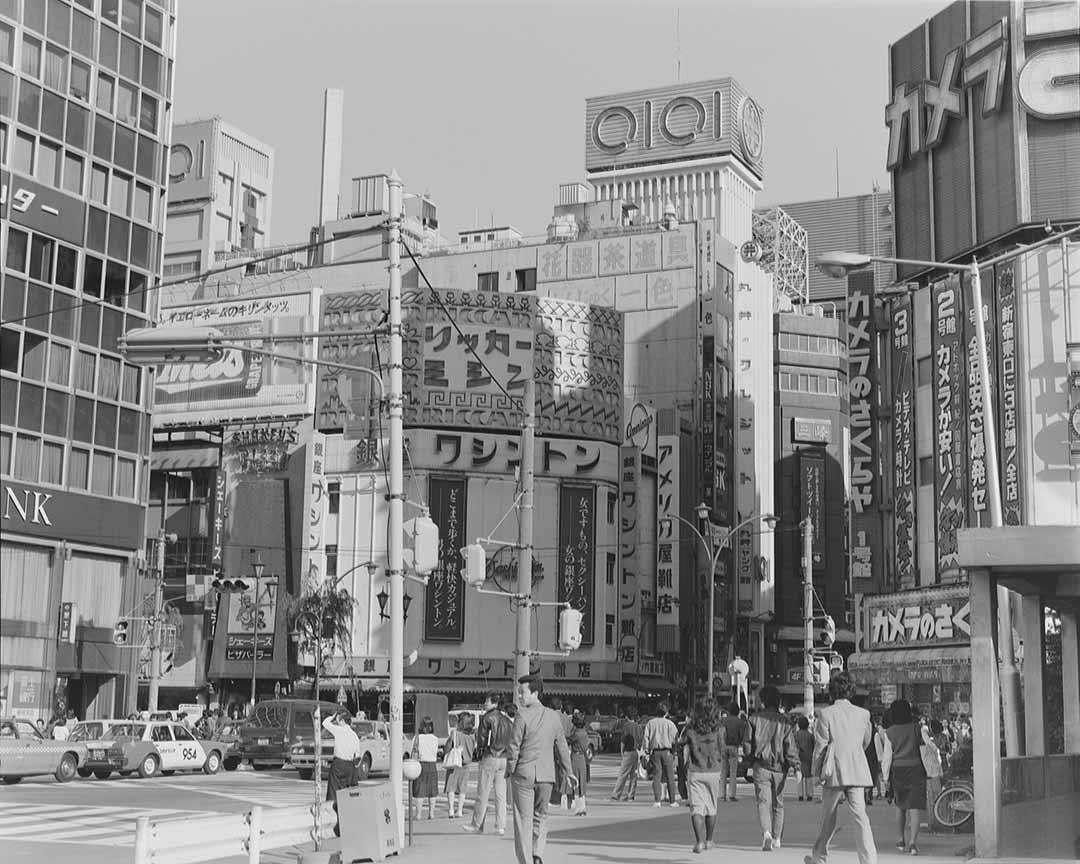
新宿駅東口交差点=1980年代
Photo:Kiichiro Yoshimoto
“Tokyo Time Slip 1984 ⇔ 2021” (Kawade Shobo Shinsha)
Photo:Kiichiro Yoshimoto
“Tokyo Time Slip 1984 ⇔ 2021” (Kawade Shobo Shinsha)
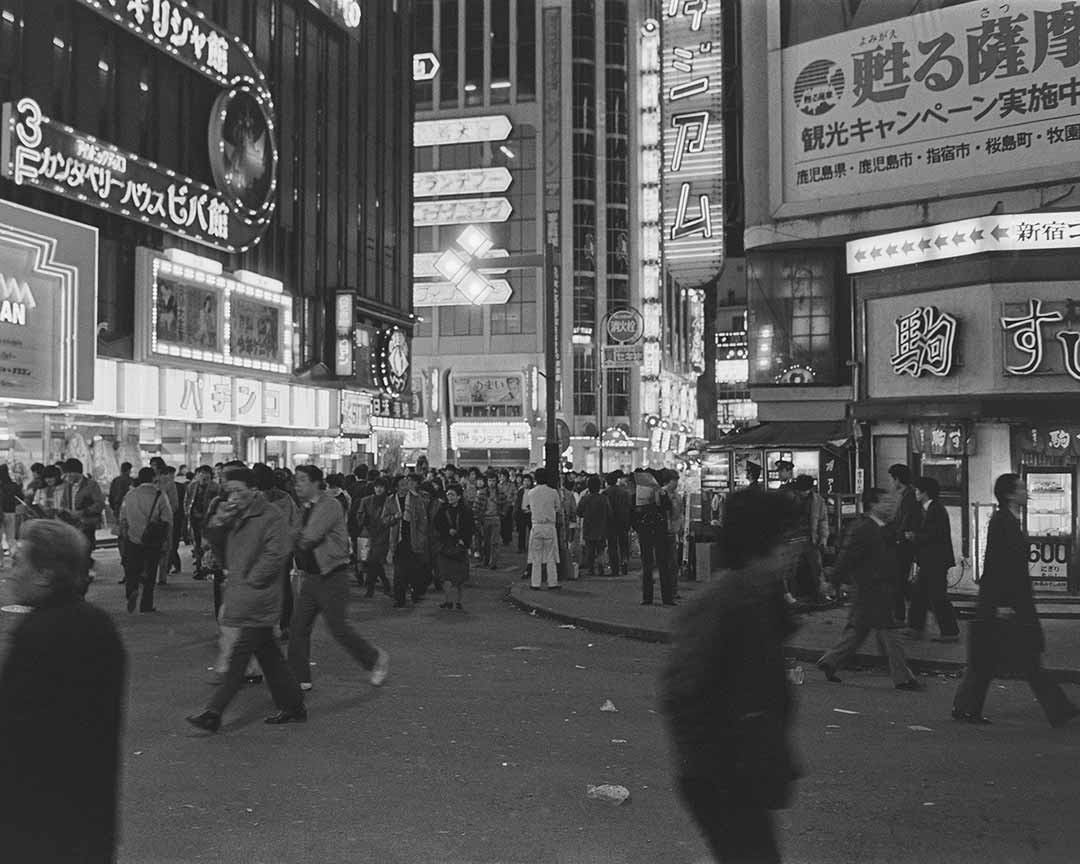
新宿歌舞伎町=1980年代
Photo:Kiichiro Yoshimoto
“Tokyo Time Slip 1984 ⇔ 2021” (Kawade Shobo Shinsha)
Photo:Kiichiro Yoshimoto
“Tokyo Time Slip 1984 ⇔ 2021” (Kawade Shobo Shinsha)
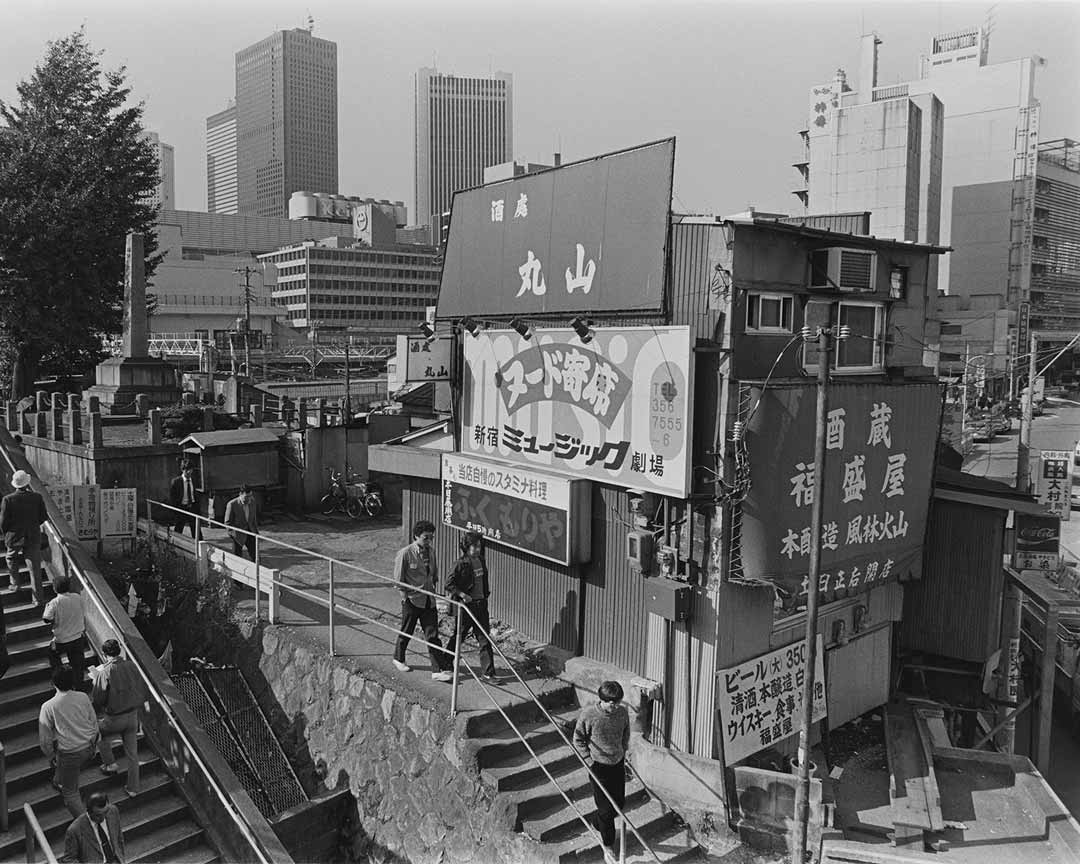
新宿駅東南口御大典広場=1980年代
Photo:Kiichiro Yoshimoto
“Tokyo Time Slip 1984 ⇔ 2021” (Kawade Shobo Shinsha)
Photo:Kiichiro Yoshimoto
“Tokyo Time Slip 1984 ⇔ 2021” (Kawade Shobo Shinsha)

新宿は “素の自分に戻れる場所”
- 「文化服装学院」を卒業して、渋谷のファイヤー通りにあったセレクトショップ「ユニオンスクエアー」に就職したのが1980年。その2年後、「ユニオンスクエアー」が業態を変えてオープンした「REDWOOD」の運営を任されることになったタイミングで自宅も田園都市線の街に引っ越したこともあって、そこからしばらくは新宿から完全に足が遠のいてしまいました。それこそ20年近く、1988年にNEPENTHESを立ち上げてからもしばらくはほとんど行ってなかったと思います。

- 新宿がまた身近なエリアになったのは2005年頃。NYオフィスから徳郎(青柳徳郎:NEPENTHESディレクター)が東京に戻ってきて、二人とも新宿に馴染みがあったことから、またちょくちょく飲みに行くようになったのがきっかけでした。若い頃に通っていた居酒屋を巡るのが懐かしくて。まだ元気に営業してるのを確認してほっとしたり。でも、そんな店も年々少なくなってしまいましたね。「紀伊国屋書店」によく行くようになったのも、ちょうどこの時期で。特に何を探すでもなく、最上階から一階までいろんな本を見てまわって、最後に地下1階の「モンスナック」でシャバシャバなカレーを食べるのが休日の楽しみでした。
- 結局のところ、自分が新宿を好きなのは、ローカルな感じがするからなんだと思います。子どもの頃から多感な二十代の半ばまで、東京でもっとも多くの時間を過ごした場所であり、ファッション業界で働くようになってからも渋谷や原宿と違って知り合いと会うこともほとんどない。だから、オンからオフへの切り替えができて、いつ行っても素の自分に戻れる。そんな地元に帰ったときのような気楽さが、新宿という街にはあるんですよね。

A Place to be My True Self
- In 1980, I started to work for Union Square, a concept shop located on the Fire Dori Street in Shibuya after graduating Bunka Fashion College. The shop was re-launched two years later as REDWOOD, and I was asked to operate it as a manager. Because I moved to a town on the Tokyu Denen Toshi Line at almost the same time, I came to visit Shinjuku less often. For about 20 years, I seldom went there after establishing NEPENTHES in 1988.

- Shinjuku became familiar for me again in around 2005. Tokuro (Aoyagi, the director of NEPENTHES) came back to Tokyo from our New York office then, and we began to revisit bars in Shinjuku together. I felt nostalgic when visiting bars I used to go during my youth. It was so nice to see them doing their business just like they did in the past. The number has been decreasing year by year, though. Around the same time, I started to go to Kinokuniya Bookstore often. I just saw around the store from the basement floor to the top floor, without having any particular books in mind, and completed my tour by having runny curry at Mon Snack on the basement floor. That was what I looked forward to on my day off.
- I think, after all, I like Shinjuku because it feels local for me. It is the place I had spent most of my time in Tokyo from my childhood to my mid 20s. Unlike Shibuya and Harajuku, I rarely bump into acquaintances in Shinjuku even after joining in the fashion industry. So, I can unplug whenever visiting the town, being my natural self. Shinjuku makes me feel as comfortable and relaxing as my hometown.
清水慶三:1958年、山梨県生まれ。NEPENTHES代表 /〈NEEDLES〉デザイナー。2023年5月には、北海道美瑛を拠点とする新たなプロジェクト「花、太陽、雨」をスタートした。
KEIZO SHIMIZU : Born in 1958 in Yamanashi Prefecture. NEPENTHES CEO/NEEDLES designer. In May of 2023 he launched HANA, TAIYO, AME, a new project based in Biei, Hokkaido.


